Key points
- number lineA straight line on which numbers are marked at equal intervals. are straight lines with numbers evenly spaced in order along the line.
- They are usually horizontal, but can have vertical representationIn maths, representation refers to a particular form in which the maths is presented. Eg, an expression, a table or a graph. too when looking at graphs, thermometers etc.
- Numbers increase when moving right on a number line. Numbers decrease when moving to the left.
- integerIntegers are numbers with no fraction or decimal part. They can be positive, negative or zero. 42, 8, and 10000 are examples of integers., decimals, and fractions can all be labelled on a number line.
How to use a number line
A number line is a representationIn maths, representation refers to a particular form in which the maths is presented. Eg, an expression, a table or a graph. of a value or a range of values. Number lines provide an ordinalDescribes a position within an ordered set. Eg, first, second, third, fourth … twentieth etc. image of a number.
- The divisionOn a scale, one part. Eg, each division on a ruler might represent a millimetre. on a number line can be any value – eg integers, decimals and fractions.
- Using a number line as a representation enables it to be compared against different numbers.
- Using marked values on a number line can help to calculate or estimate readings on the same scale.
- Number lines can be used to convert between different units – a double number lineA double number line consists of two number lines with corresponding pairs of values. Sometimes these are shown as a single number line with values either side. can be used for this.
Example: number lines
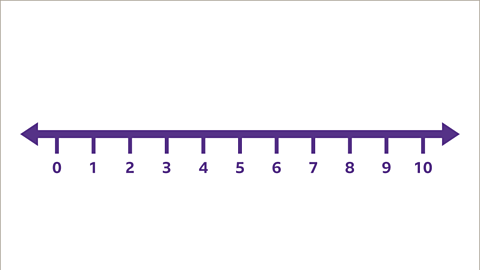
Image caption, This number line shows integer values. The numbers are evenly spaced on the number line. Each step increases by 1
Image caption, To mark a value on the number line, eg the number 2, start at zero and take 2 steps to the right.
Image caption, Number lines can show decimals as well as integers. This number line represents the values between 4 and 5. Each step increases by 0.1
Image caption, Number lines can also show fractions as values. This number line represents the values between 0 and 1. Each step increases by 1вЃ„10 (one tenth).
Image caption, A double number line can be helpful when converting between different units. Eg, this double number line shows miles and kilometres (km). 10 miles is in the corresponding position to 16 km. This means that 10 miles is the same as 16 km.
1 of 5
Question
Not all number lines are drawn horizontally. The same skills can be applied to read values represented by a vertical number line.
What value is represented by the arrow?
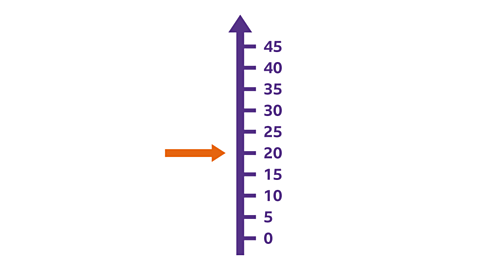
The arrow represents the value of 20
How to work out a missing value on a number line
Not all numbers on a number line have a value written next to them. It is often necessary to calculate these missing values to read the number line accurately.
There are a few ways to calculate a missing value on a number line. One way is to work out the size of each step on the number line. To do this:
- Find the differenceThe numerical difference between two numbers is found by comparing the quantities. A difference is always a positive value. The difference between 3 and 5 is 2, the difference between 5 and 3 is 2 between the two given values on the number line.
- Count the number of steps between the two values.
- Divide the difference by the number of steps.
- This gives the size of each step. Use this to complete the missing values on the number line.
Sometimes you can find a missing value without calculating each step. For example, it could be quicker to find another value which is halfway between two known points on a number line.
Example: work out the missing value
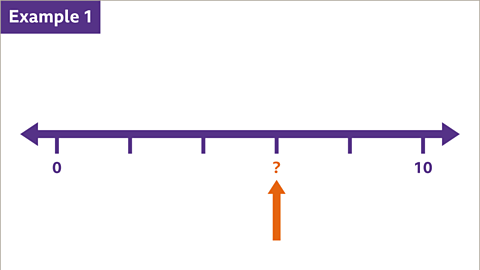
Image caption, What is the value represented by the question mark?
Image caption, Look at the number line to see what values it has already. This number line has the values 0 and 10
Image caption, Count the number of steps between the two values. There are 5 equal sized steps between 0 and 10. The difference is 10
Image caption, Divide the difference by the number of steps. 10 Г· 5 = 2. 10 is shared into 5 steps. Each step must have a value of 2
Image caption, Start at 0. Take 3 steps to the right. Remember each step has a value of 2. The missing value is 6
Image caption, This number line has 30 and 50 identified. What is the value represented by the question mark?
Image caption, The missing value is exactly halfway between the values of 30 and 50. Halfway between 30 and 50 is 40. The value of the question mark is 40. The value represented by the question mark can be identified here without calculating the size of each step.
1 of 7
Question
What is the missing value represented by the question mark on the number line?
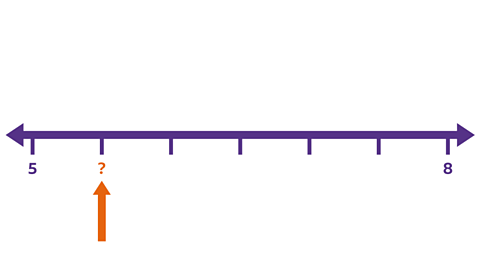
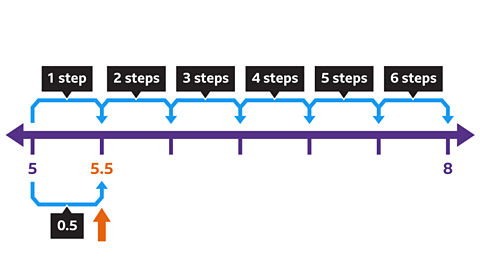
The missing value is 5.5
The number line starts at 5 and goes up to 8. This is a difference of 3. There are 6 equal steps.
Divide the difference by the number of steps. 3 Г· 6 = 0.5.Each step has a value of 0.5
One step to the right of 5 is 5.5
Practise number lines
Try practising reading number lines and working out missing values with this quiz. You might need a pen and paper to solve some of these questions.
Quiz
Real-world maths
Number lines are used regularly in everyday life. They are often drawn as horizontal lines, but can also be drawn vertically or curved. Number lines can also be used to convert between different units of measure.
Number lines such as rulers and tape-measures are used to measure a length or distance from one point to another. Rulers are number lines split into equal increments such as millimetres (mm) and centimetres (cm).
Thermometers are also a type of number line used to measure temperature, which is a measure of how hot or cold something is. For example, water freezes at 0В°C (degrees Celsius) and boils at 100В°C
Scales are often represented as a curved line. They are number lines used to measure weight eg, an amount of produce such as fruit or vegetables, often measured in grams (g) or kilograms (kg).
Measuring jugs are number lines used to measure the volume of liquids, eg millilitres (ml).
Watch this video to find out some of the ways we use number lines.
Play the Divided Islands game! gamePlay the Divided Islands game!
Using your maths skills, help to build bridges and bring light back to the islands in this free game from ґуПуґ«ГЅ Bitesize.

More on Place value
Find out more by working through a topic
- count5 of 5
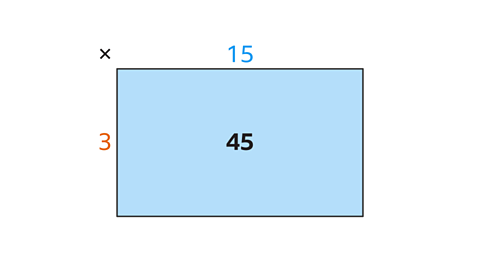
- count1 of 5
